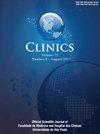Association between decreased p53 expression, elevated serum CagA levels, and oral squamous cell carcinoma
IF 2.4
4区 医学
Q2 MEDICINE, GENERAL & INTERNAL
引用次数: 0
Abstract
Objective
p53 is a key tumor suppressor, aCnd loss of p53 function promotes the progression of many cancers. Helicobacter Pylori (HP) is mainly involved in the progression of gastric carcinoma, but its role in Oral Squamous Cell Carcinoma (OSCC) is controversial. The primary objectives of this study were to investigate the expression levels of p53 in OSCC tissues and to examine the serum levels of CagA in OSCC patients. Additionally, the authors aimed to explore the potential association between p53 expression and CagA levels in OSCC.
Method
A total of 65 patients diagnosed with OSCC and 42 healthy volunteers were recruited in this study. The clinical pathological parameters of all patients were collected. Reverse transcription-quantitative polymerase chain reaction was performed to detect the expression of p53 in tissues. Receiver Operating Characteristics Curve (ROC) analysis was used to assess the sensitivity of p53 for the diagnosis of OSCC. The concentration of Cytotoxin-Associated gene A (CagA) in serum was assessed by enzyme-linked immuno sorbent assay.
Results
The results indicated that the p53 expression in oral mucosal tissues was downregulated while the concentration of CagA in serum was increased in OSCC patients. Besides, p53 expression was correlated with tumor stage. OSCC patients showed a higher HP positive rate than in healthy people.
Conclusions
In conclusion, this study demonstrated that decreased p53 expression and elevated serum CagA levels might be correlated with OSCC progression and diagnosis.
p53表达降低、血清CagA水平升高与口腔鳞状细胞癌之间的关系
目的p53是一种重要的肿瘤抑制因子,p53功能的缺失促进了许多肿瘤的进展。幽门螺杆菌(HP)主要参与胃癌的进展,但其在口腔鳞状细胞癌(OSCC)中的作用仍有争议。本研究的主要目的是研究OSCC组织中p53的表达水平,并检测OSCC患者血清中CagA的水平。此外,作者旨在探讨OSCC中p53表达与CagA水平之间的潜在关联。方法本研究共招募65例OSCC患者和42名健康志愿者。收集所有患者的临床病理参数。逆转录-定量聚合酶链反应检测p53在组织中的表达。采用受试者工作特征曲线(Receiver Operating characteristic Curve, ROC)分析评估p53对OSCC诊断的敏感性。采用酶联免疫吸附法测定血清中细胞毒素相关基因A (CagA)的浓度。结果OSCC患者口腔黏膜组织中p53表达下调,血清中CagA浓度升高。p53的表达与肿瘤分期相关。OSCC患者HP阳性率高于健康人。结论本研究提示p53表达降低和血清CagA水平升高可能与OSCC的进展和诊断有关。
本文章由计算机程序翻译,如有差异,请以英文原文为准。
求助全文
约1分钟内获得全文
求助全文
来源期刊

Clinics
医学-医学:内科
CiteScore
4.10
自引率
3.70%
发文量
129
审稿时长
52 days
期刊介绍:
CLINICS is an electronic journal that publishes peer-reviewed articles in continuous flow, of interest to clinicians and researchers in the medical sciences. CLINICS complies with the policies of funding agencies which request or require deposition of the published articles that they fund into publicly available databases. CLINICS supports the position of the International Committee of Medical Journal Editors (ICMJE) on trial registration.
 求助内容:
求助内容: 应助结果提醒方式:
应助结果提醒方式:


